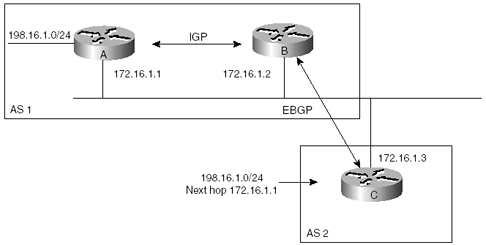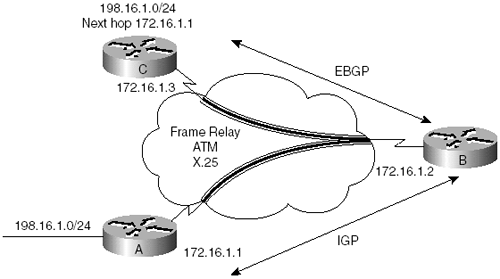8-17 neighbor ip-address peer-group-name next-hop-self
| < Free Open Study > |
8-17 neighbor { ip-address peer- group - name } next -hop-selfSyntax Description:
Purpose: When a BGP router learns routes via EBGP, and those routes are advertised to an IBGP neighbor, the next-hop information is sent unchanged. This command allows a BGP router to change the next-hop information that is sent to IBGP peers. The next-hop information is set to the IP address of the interface used to communicate with the neighbor. Cisco IOS Software Release: 10.0. Peer group support was added in Release 11.0. Configuration Example: Setting Next-Hop Information for Advertised PrefixesEvery prefix that is advertised using BGP contains next-hop information. Figure 8-15 shows the next-hop behavior for EBGP and IBGP. The advertisement for network 198.16.1.0/24 from Router B to Router A contains a next hop of 172.16.1.1. EBGP next-hop information is preserved when the prefix is advertised via IBGP. Router B advertises network 198.16.1.0/24 to Router C, with the next-hop information received from Router A. Figure 8-15. Next Hop for EBGP and IBGP Connections On a multiaccess network, such as Ethernet or Token Ring, the next-hop behavior is as shown in Figure 8-16. Router B learns about network 198.16.1.0/24 from Router A via IGP. Router B advertises 198.16.1.0/24 to Router C via EBGP with the next-hop information set to the address of Router A. This is done to avoid the extra hop of sending packets destined to network 198.16.1.0/24 to Router B. Figure 8-16. Next Hop for Multiaccess Networks The next-hop behavior for a nonbroadcast multiaccess (NBMA) network is similar to that of a multiaccess network. Figure 8-17 shows a partially meshed NBMA network using a hub-and-spoke configuration. PVCs have been configured between the hub (Router B) and the spokes (Routers A and C). There is no PVC from Router A to C. Both PVCs are assigned to the same IP subnet, 172.16.1.0/24. Because the PVCs are on the same IP subnet, Router B sets the next-hop information for 198.16.1.0/24 to 172.16.1.1 when sending an update to Router C. Because Router C does not have a PVC to Router A, routing for this network will fail. In this situation, Router B needs to set the next hop for 198.16.1.0/24 to 172.16.1.2, as shown in the following configuration: Figure 8-17. Next Hop for NBMA Networks Router B router bgp 1 neighbor 172.16.1.3 remote-as 2 neighbor 172.16.1.3 next-hop-self VerificationVerify the next hop for network 198.16.1.0/24 on Router C by using the show ip bgp command on Router C: rtrC# show ip bgp BGP table version is 22, local router ID is 172.16.1.13 Status codes: s suppressed, d damped, h history, * valid, > best, i - internal Origin codes: i - IGP, e - EGP, ? - incomplete Network Next Hop Metric LocPrf Weight Path *> 198.16.1.0/24 172.16.1.2 0 0 2 i Troubleshooting
|
| < Free Open Study > |
EAN: 2147483647
Pages: 300


